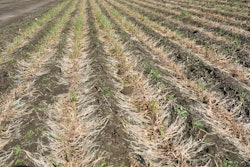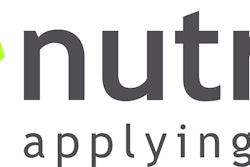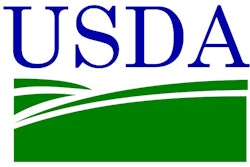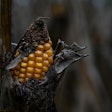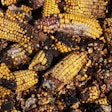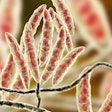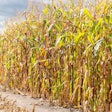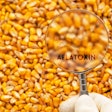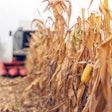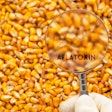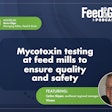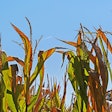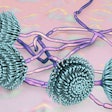
Any number of harvest, storage and handling practices can set the stage for mold and mycotoxin growth, which can be detrimental and potentially dangerous for livestock. From the fields to feed bins, mycotoxins pose challenges. But with a little background and knowledge, livestock producers can better prevent, recognize and manage mycotoxin contamination.
That’s the reason behind Phibro’s seven-part MYCOmpass™ webinar series, which brings together the industry’s top experts in molds and mycotoxins to educate livestock producers and nutritionists about the issue.
In the first of these webinars, Dr. Lon Whitlow, professor emeritus, NC State University, leads a webinar titled “An Introduction to Mold and Mycotoxins: Toxic Effects and Preventative Management” to provide producers with mold and mycotoxins identification, prevention and treatment techniques. The webinar is available for free at Phibro Academy (academy.pahc.com), Phibro Animal Health Corp.’s digital information platform, and can be accessed here.
“Under certain conditions, mold can form and proliferate in the fields, in storage or in the feed bunks — and where there’s mold, there are often mycotoxins,” states Whitlow. “Given this prevalence, coupled with the immense impact mycotoxin contamination can have on an animal’s immune and reproductive systems, feed intake and production, it’s imperative that producers know the causes of mycotoxins to better recognize and treat the symptoms.”
Mycotoxins: Toxic Effects and Preventative Management
It’s often said that “knowledge is power.” In his webinar, Whitlow arms producers with some basic mycotoxin knowledge:
- In the field, mycotoxins are routine and are the byproducts of stressed molds. Insects, disease, low soil fertility and excess water can set the stage for mold growth, which in turn may produce mycotoxins. Once harvested, crops are subject to molds in storage, so Whitlow advises farmers to aerate dry feeds and properly pack and cover silage. Also, consider mold inhibitors or microbial fermentation aids to keep feed mold-free. “Cold, wet conditions and winter damage can set the stage for molds and mycotoxins, which require water and just a small amount of oxygen,” warns Whitlow, who adds that molds may grow in a wide variety of environments, such as when feedstuff pH is between 4.0-8.0 and when humidity tops 70%. Molds can even grow in the depths of a silo, where there it has just enough oxygen to support growth, even though pH may be low.
- Where you find evidence of one mycotoxin, there are likely more. There are thousands of known mold species, and they may replicate quickly under ideal environmental conditions. Fortunately, approximately 2/3 of molds are non-toxigenic or don’t produce mycotoxins, but the remaining 1/3 may produce more than 500 mycotoxins. “A producer might sample a feed and find one to two mycotoxins reported in the testing results, but when a few are detected, there are likely 20 to 30 mycotoxins present due to the limited number of mycotoxins tested by commercial analytical labs,” says Whitlow.
- Mycotoxicosis can have widespread effects on animal health. Mycotoxins may impact almost every aspect of immunity, reducing an animal’s ability to process antigens and build antibodies to those antigens. This reduces the maturation of disease-fighting immune cells and also reduces the production of cytokines, thereby limiting the communication of immune cells. The effects on the immune system lowers an animal’s ability to fight disease. Mycotoxins can also have dire intestinal effects, creating a loss of barrier function, reducing enzymes, increasing intestinal pathogens and causing diarrhea, because animals are unable to maintain water balance.
- Symptoms of mycotoxin toxicity can be difficult to diagnose, and effects differ by mycotoxin and species. Two of the more common mycotoxins are fumonisins and deoxynivalenol (DON). Fumonisins can disrupt metabolism and cause nerve degeneration, while DON may cause intestinal irritation, reduction in weight gain, changes in feed intake or lowered immunity. Aflatoxins tend to target the liver, while zearalenone often reduces conception and reproductive performance. One of the least prevalent but potentially most dangerous of all, T-2 toxins, produced by Fusarium molds, can cause cellular injury to multiple organs, resulting in increased disease incidence and even death.
- Producers can reduce the threat of mycotoxin toxicity. If contaminated feeds are discovered, Whitlow encourages producers to sample and test their feeds to help identify what mycotoxins are present and to dilute or remove the contaminated feed if possible. He also recommends they consider feeding immune enhancers, antioxidants, fibers, buffers or microbials to help strengthen immune systems and GI tracts and include binding agents in feeds to help protect animals from the harmful effects of mycotoxins.
“While mold occurrence in the field is very routine, if left unchecked, resulting mycotoxins can produce acute or chronic toxicity,” Whitlow cautions. “While prevention in the field and in storage is important, it’s also incumbent upon livestock producers to be vigilant in looking for signs of illness that might be a result of mycotoxin contamination and to act accordingly. The best treatment requires multiple approaches, from buffers to binders.”
Phibro’s AB20® nutritional specialty product is a bentonite adsorbent, containing hydrated sodium and calcium aluminosilicates, that reduces caking and flowability issues by binding moisture that is present in feed. Lower moisture in feed reduces the potential for mold growth — and lowering mold growth in feed helps improve its quality.
New Trends in Mycotoxin Management, Mitigation
Whitlow’s webinar sets the stage for a series of six more mycotoxin webinars to be offered by Phibro Academy, as part of Phibro’s MYCOmpass mycotoxin awareness initiative. Other topics include:
- Mycotoxins and Food Security: Looking Beyond the Impacts of Mycotoxins on Animal Agriculture
- Smart Strategies for Effective Mycotoxin Management
- New Studies and Trends in Understanding the Role of Mycotoxins in Feed Production
- New Methods for Evaluation of Mycotoxin Mitigation Strategies
- Understanding Multi-Mycotoxin Analysis Strategies
- New Technologies and Approaches to Deal with Mycotoxins
“We’re proud to share timely expertise from one of the nation’s leading mold and mycotoxin experts,” says Paulo Rezende-Napier, marketing director, Phibro Animal Health Corporation. “I encourage all producers, nutritionists and animal health professionals to visit the Phibro Academy website to learn more about this important topic and a range of others affecting animal health and producer profitability.”
Registration for Phibro Academy is free.
About Phibro Animal Health Corp.
Phibro Animal Health Corporation is a diversified global developer, manufacturer and marketer of a broad range of animal health and mineral nutrition products for livestock, helping veterinarians and farmers produce healthy, affordable food while using fewer natural resources.



